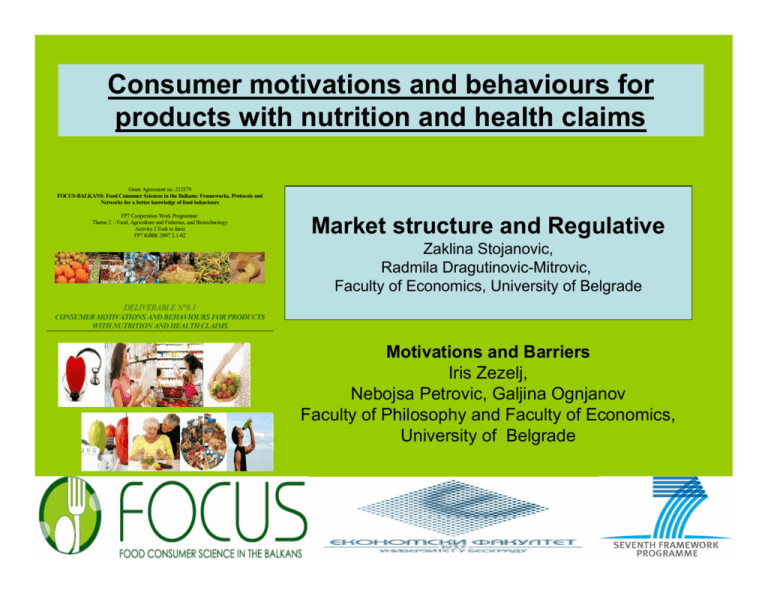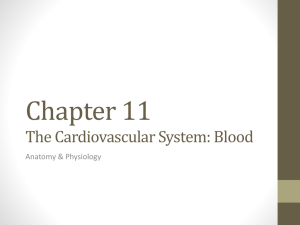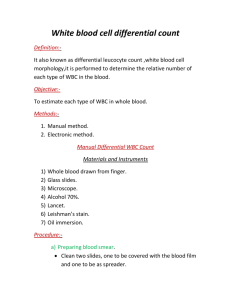Consumer motivations and behaviours for products - Focus
advertisement

Consumer motivations and behaviours for products with nutrition and health claims Grant Agreement no. 212579 FOCUS-BALKANS: Food Consumer Sciences in the Balkans: Frameworks, Protocols and Networks for a better knowledge of food behaviours FP7 Cooperation Work Programme: Theme 2 – Food, Agriculture and Fisheries, and Biotechnology Activity 2 Fork to farm FP7 KBBE 2007 2.1-02 Market structure and Regulative Zaklina Stojanovic, Radmila Dragutinovic-Mitrovic, Faculty of Economics, University of Belgrade DELIVERABLE N°6.1 CONSUMER MOTIVATIONS AND BEHAVIOURS FOR PRODUCTS WITH NUTRITION AND HEALTH CLAIMS Motivations and Barriers Iris Zezelj, Nebojsa Petrovic, Galjina Ognjanov Faculty of Philosophy and Faculty of Economics, University of Belgrade Starting points – diet and health • Obscurity by the end of 19th century. • Discovery of the essential elements and vitamins, particularly in the context of deficiency diseases during the first 50 years of the 20th century. • During the 1970s the shift in emphasis from under nutrition to over nutrition and disease. Health claims and public policy • Health claims in food marketing are controversial. • Many government regulators and consumer advocates believe that such claims are bound to be misleading. Health claims and labeling history: Where was the market born? • In the mid 1970s, nutrition and health research suggested a link between the consumption of fiber and the incidence of colon cancer. • In October 1984, the Kellogg Company began advertising and labeling campaign that cited the National Cancer Institutes statements. • This campaign was in direct violation of long-standing Food and Drug Administration (FDA) policy in the area, which essentially created a ban on health claims for food products. • Private advertising added initial flow of information related to pubic health policy. • Two periods: – – pre-advertising period and advertising period. The market development - benefits • Public health: nutrition and diseases – Deaths by leading reasons (cardiovascular diseases, cancer…). – Are they food/diet born diseases? • Public health authorities found commercial advertising of health claims to be useful supplement of public health policy. – Governments need to work with private sector, consumer groups, academics and research community. Benefits/Costs Benefits Costs I – stakeholders 1st order effects 2nd order effects Wider diet-health/disease information spread to general public Positive reaction of competitors. Consumer is mislead and his health status might be worse. Stakeholders credibility is questionable. If the claim is false Cost II – Regulative If the claim is true The claim is accepted: Negative reaction of competitors (over-fortification and over-emphasizing the importance of some component of food) The claim is forbidden: Negation of the market benefits Health claims EU – WBC parallels • EU regulation on nutrition and health claims made on – Regulation (EC) No 1924/2006 http://ec.europa.eu/food/food/labellingnutrition/claims/index_en.htm – Nutrition claims – Health claims • Types of health claims – Article 13. • Claim must indicate the role of nutrients in the development and functioning of the body (so-called functional claims). – Article 14. • Reduction of disease risk claims (so-called risk-disease claims). • Claims referring to children's development and health • In most countries in the region there is no specific low on health claims. Focus-Balkans WP6 research questions • Market with health claims in WBC region (supply and demand analysis) – current state and perspectives – Level of the market development – Issues – Perspectives • Is the regulative existence precondition for the N&H market development? • What are the major impressions about this market segment development from the perspective of the public authorities? The research methods and results Current state – Shop check • H&N products by product groups • Origin of N&H products • Nutrition and health claims – Western Balkan Countries: • • • • • • 1. FYR Macedonia 2. Montenegro 3. Serbia 4. Slovenia 5. Croatia 6. Bosnia and Herzegovina Structure of the surveyed N&H claimed products by product groups (in %) FYR Macedonia Slovenia Montenegro Serbia Croatia B&H 1. Milk and Yogurt 37.1 31.0 36.5 33.7 22.3 21.5 2. Margarine 7.9 9.0 5.8 5.4 3.2 6.7 3. Nectars 21.8 16.0 20.0 17.5 20.2 33.7 4. Other 15.6 14.0 18.5 9.6 16.0 18.1 5. Dietetic 17.6 30.0 19.2 33.8 38.3 20.0 Total: 100 100 100 100 100 100 Source: IPSOS Strategic Puls Origin of N&H products by countries Other WBC: 8.4% Other countries: 0% Other Countries: 1.1% Other WBC: 7.9% Croatia: 37.9% Slovenia: 38.6% EU: 54.5% EU: 52.6% WBC 17.5% Other countries 0.7% Other countries 0.6% Macedonian 30.7% WBC 41.4% EU & Swiss 26.5% Serbian 55.4% Montenegro 7.7% EU & Swiss 27.1% Other countries: 1.0% EU & Swiss 19.2% B&H: 23.8% Other WBC: 47.6% WBC 73.1% Source: IPSOS Strategic Puls EU: 27.6% Claims made on food Maximum number of N&H claims per product origin • Macedonia: EU up to 4, domestic and WBC producers up to 7; • Slovenia: EU up to 4, WBC up to 2, domestic producers up to 3; • Montenegro: EU up to 4, WBC up to 6 , domestic up to 3; • Serbia: EU up to 4 (Swiss up to 9), WBC up to 7, domestic up to 5; • Croatia: EU up to 4, WBC up to 2, domestic up to 3; • Bosnia and Herzegovina: EU up to 4, WBC up to 4, domestic up to 3. Number of the health claims products and their share in the total number of N&H claimed products, by countries: N&H claims Health claims % FYR Macedonia 140 27 19 Slovenia 100 20 20 Montenegro 52 9 17 Serbia 166 24 14 Croatia 94 19 20 B&H 105 27 26 Source: IPSOS Strategic Puls The main shop check results Country Regulative No. products surveyed Max claims per prod. Slovenia yes 100 3 Croatia yes 94 3 Serbia no 166 7 B&H no 105 4 Montenegro no 52 6 Macedonia no 140 7 Dominant type of food Milk and yoghurt and dietetic food Dietetic food Milk and yoghurt and dietetic food Juices Milk and yoghurt Milk and yoghurt Share Domnant producers Share Share of HC 19% 30-31% EU 54.50% 38.30% EU 52.60% 20% 33-33% SRB 58.40% 17% 33% WBCs 47.60% 14% 36.50% WBCs 75% 20% 37.10% WBcs 41.40% 26% Products with N&H claims – methods of the research N&H claimed products – In-depth interviews with market stakeholders C r iter ia C a teg o r y o f p r o d u c ts w ith H & N c la im S ta k e h o ld er C o u n tr y S tr u c tu r e N o o f in t er v ie w s J a m fo r p er s o n s s u ff er in g fr o m d ia b et es 15 Y o g h u r ts w it h p r o b io tic s 25 M ilk e n r ic h e d w ith v ita m in s a n d m in er a ls “ L ig h t m a r g a r in e” w it h r e d u c e d fa t content J u ic e e n r ic h e d w ith v ita m in s a n d m in er a ls 17 28 21 O th er p r o d u c ts 14 P r o c es s o r 36 R eta iler 26 E x p er t 18 B o s n ia a n d H er z e g o v in a 14 C r o a tia 9 EU 7 M a c e d o n ia 11 M ontenegro 11 S er b ia 18 S lo v e n ia 10 WBC N&H claimed products market structure Country Regulated Dominant producer Market share Growing rates Motives Barriers Rank of Health criteria Slovenia Yes EU Higher High Market Position Information 3 Croatia Yes EU Average High Consumers Regulative 2 Serbia No SRB Average High Image Lack of scientific support 5 Macedonia No WBC Lower High Consumers Lack of scientific support 4 B&H No WBC Lower High Profit Finance 3 Montenegro No WBC Lower High Consumers Image Finance 2 Barriers for purchase of the N&H claimed products (the market stakeholders opinion) 6 5 • The main problems are related to: – High price – Taste • Opinion of the economic stakeholders was unified: median rank 4 3 2 1 0 Category I P_Price_criter Category II P_Taste_criter Category III P_Safety_criter Category IV P_Fresh_criter Category V P_Health_dim_criter Category VI P_Label_criter 5.00 4.50 100 4.00 average mark 3.50 3.00 2.50 East West North 50 2.00 1.50 1.00 0 0.50 0.00 Category I P_Price_restr 1st Qtr Category II 3rd Qtr Category III P_Econ_diffic_restr Category IV P_Nutrit_know_restr Category V P_Avail_restr Category VI P_Habit_restr • economic difficulties, • price and • habits are the main barriers for the N&H claimed products higher consumption. WBC N&H claimed products market perspective 5.00 4.50 4.00 average mark 3.50 3.00 2.50 2.00 1.50 1.00 0.50 0.00 Category I P_Nutr_know_factor Category II P_Health_factor Category III P_Public_policy Category IV Category V P_Purchase_power P_Lifestyle Category VI P_Fashion WBC N&H claimed products market – experts opinion (the public authorities opinion) Statement Average mark Consumer demand related to products with nutrition or health claim is high today. 2.57 Demand for products with nutrition or health claim is increasing. 3.78 Supply of products with nutrition or health claim has significant influence on the demand for these products. 4.28 Companies’ promotional activities have significant influence on demand for products with nutrition or health claim. 4.57 Price of products with nutrition or health claim has significant influence on the demand for these products. 4 Nutrition and health claims improve consumer awareness on the importance of food. 2.85 Nutrition and health claims help consumers improve consumer dietary habits. 3.35 Nutrition and health claims are suited to the main health concerns seen by health officials. 2.5 Nutrition and health claims on food products improve public health. 2.85 The claims made on food products in our country are truthful. 2.42 Source: IPSOS Strategic Puls Conclusion • WBC N&H claimed products market perspective: – Market: young, educated, higher income, urban and mostly women consumers. – In developed WBC N&H markets targeted population is even now extended to mothers and children. – After innovators and early adopters, elderly population with higher and middle income also became interested consumer group for products with N&H claims at WBC. The athletes and businessmen are seen as new consumers. • THE MARKET IS GOING THROUGH MULTIDIMENSIONAL TRANSITION. • ACTIVE PUBLIC POLICY in the field of research can promote the concept of healthy lifestyle and healthy eating in the region. The highly regulated market of products with N&H claims can be used as an efficient channel for information dissemination to the general public. Grant Agreement no. 212579 FOCUS-BALKANS: Food Consumer Sciences in the Balkans: Frameworks, Protocols and Networks for a better knowledge of food behaviours Thank you for attention! FP7 Cooperation Work Programme: Theme 2 – Food, Agriculture and Fisheries, and Biotechnology Activity 2 Fork to farm FP7 KBBE 2007 2.1-02 Zaklina Stojanovic, PhD Associate Professor Faculty of Economics University of Belgrade zaklina@ekof.bg.ac.rs DELIVERABLE N°6.1 CONSUMER MOTIVATIONS AND BEHAVIOURS FOR PRODUCTS WITH NUTRITION AND HEALTH CLAIMS www.focus-balkans.org






